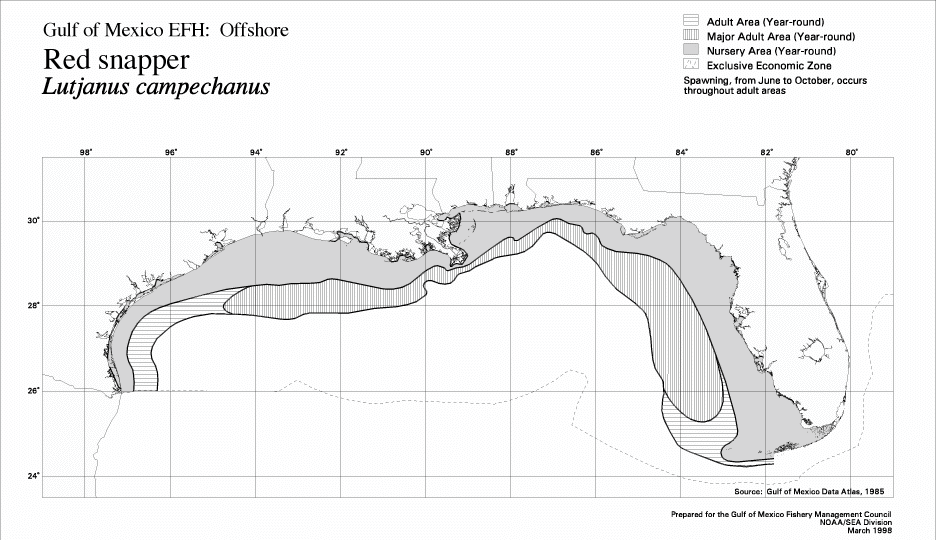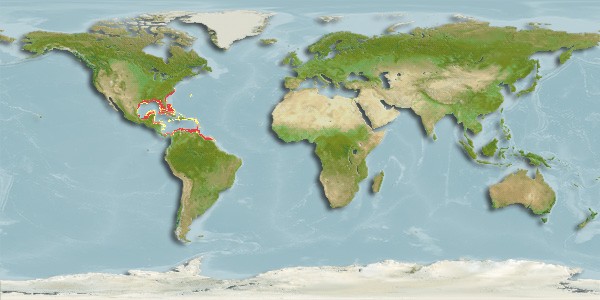
Fish and Fisheries
Where are the major fisheries of the world?
The great fisheries of the world are located close to coasts, over continental shelves, at high latitudes, along the equator, and around oceanic seamounts that reach close to the surface. Fish are common in these areas because food is plentiful. In all these areas, nutrients support large blooms of phytoplankton that are at the base of the marine fisheries food web.
- Near the coast, runoff from the land brings nitrates, phosphates, and many other nutrients.
- Along many coasts, especially west coasts of continents (east coasts of the oceans), upwelling brings up nutrient rich waters from deeper in the ocean.
- At high latitudes, nutrients are brought up by mixing during winter storms.
- Upwelling is common on the equator, and here too upwelling brings up nutrients.
- Turbulent currents around seamounts also bring up nutrients.
The phytoplankton feed zooplankton, which feed small fish, which feed large fish.
Some of the important fishing areas are:
- Shallow seas such as the Bering Sea.
- Large continental shelves such as the Grand Banks offshore of eastern Canada.
- The north Atlantic from the Grand Banks to Iceland, Scotland, and Norway.
- The eastern equatorial Pacific.
- Upwelling areas offshore of California, Peru, Namibia, and Somalia.
Types of Fish
The types of commercial fish found in the major fisheries depends on where the fish live and what they eat. Some live on the bottom, others live closer to the surface. Some live in cold water, others in tropical waters. Some eat small fish, others are top predators that eat larger fish. Tuna are found in warmer water, cod in colder water. Red snapper were common in the Gulf of Mexico. Pollack are common in the Bering Sea. Anchovies are common offshore of Peru and California. So, before we can discuss fisheries, we need to know more about fish.
As you browse through the information below, notice the shape of the fish. Some such as Atlantic mackerel are streamlined, which enables them to swim fast to catch other fish. Others, such as flounder, are shaped to hide in the bottom. Notice that form follows function. Can you look at the shape of an unfamiliar fish and deduce something about its habits?
Each species of fish has a two-part scientific name in latin that uniquely identifies the fish. For example, cod has the scientific name Gadus morhua. It belongs to a group of similar fish within the genus Gadus. The genus name is capitalized. The particular type of cod is the species morhua. The species name is not capitalized. The scientific name is unique. Common names often refer to several different species of fish. For example, the common name Arctic Cod refers to three very different species: Arctogadus glacialis, Boreogadus saida, and Eleginus nawaga from three genera. They are only slightly related.
Northeastern Atlantic Commercial Fish
NOAA's National Marine Fisheries Service
Northeast Fisheries Science Center has a useful set of pages describing
the Fishery Resources off the
Northeastern United States. Similar fish are found in cold water
regions of all the oceans. Here are a few of the important varieties
of commercial fish.
- Near Bottom Fish. Cod (Gadus morhua)
is an example. Learn about cod at the cod
page. Cod live near the bottom, and they eat a variety of fish
and invertebrates. Cod was once an
important commercial fish in the Grand Banks and Gulf of Maine, but
now it is mostly gone. It is still caught near Iceland, and in the
north Pacific.

Cod. From Northeast Fisheries Science Center.
- Bottom Fish. Flounder are
an example. Learn about the yellowtail
flounder (Limanda ferruginea) a bottom fish widely served in restaurants.
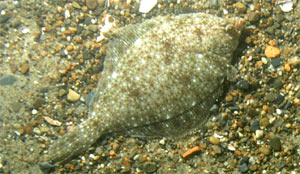
Yellowtail flounder. From Northeast Fisheries Science Center.
- Deep Bottom Fish. The Orange Roughy,
originally known as the slimehead,
is found at depths of 180 m to 1800 m on seamounts, deep-sea ridges,
and oceanic cliffs on continental slopes around the world, especially
in the southern ocean, Australia, and New Zealand. Because it lives
in cold, deep water, it grows very slowly. It is one of the longest-lived
fish species, reaching an age of 150 years. It reaches maturity at
an age of 27
years. Fish stocks have been severly over fished, and the Australian
government recommends it be placed on the list of endangered species.
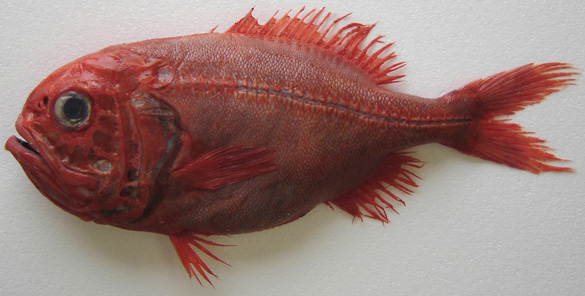
Orange Rought. From New Zealand Seafood Industry.
- Open Ocean Fish. Learn about the Atlantic
mackerel (Scomber scombrus) a pelagic (open ocean) fast-swimming
predator that lives in cool or cold water.
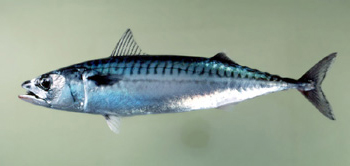
Atlantic mackerel. From Northeast Fisheries Science Center.
- Anadromous Fish. Read about the Atlantic
salmon (Salmo salar), an anadromous fish (lives in the ocean,
and returns to rivers to spawn). It once was common in Maine, and
a popular sea food.
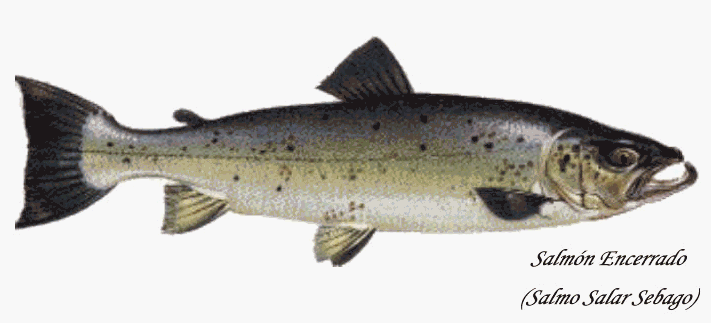
Atlantic salmon. From Sebago Canoe Club.
- Tropical Open Ocean Fish. Read about
the Albacore
Tuna (Thunnus alalunga), the tuna in your tuna sandwich, a warm
water open-ocean fish, able to search large areas for food.
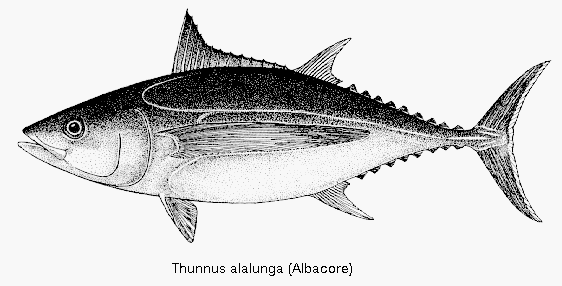
Albacore tuna. From Food and Agriculture Organization via Fishbase.
Alaskan Commercial Fish
The Alaskan fishery is one of the world's great fisheries, and the most
important for the US. 2.5 million metric tons of fish, worth $1.3 billion
were landed in 2006. The most valuable fish was Pollock, accounting
for 60% of the weight of fish landed in 2006. Learn about Alaskan
Fish (use
pull-down species menu) and view this animation of where Alaskan
pollock were caught in 2001. The Alaskan Pollock, also
known as the Walleye Pollock or Theragra chalcogramma, an important,
near-bottom fish common in the Bering Sea. (View more maps
by at the Map
Page for the Alaska Fisheries
Science Center).
Gulf of Mexico Commercial Fish
TheGulf of Mexico is the second most important fisheries area in the US.
0.6 million metric tons of fish, worth $0.7 million were landed in 2006.
New England, which was once the most important fishery region, landed
only 0.3 million metric tons of fish, worth $0.9 million in 2006.
Distribution of distribution of red Snapper (Lutjanus campechanus) in the northern Gulf of Mexico. From NOAA Offshore Species Abundance & Distribution Maps.
Other Fish Types
Many other important fish live in the ocean, from the deepest waters to
shallow coral reefs. Most are not commercially valuable, so I have not
described them here. This is not to say they are unimportant. But, we
are concentrating on commercial fish.
Fishbase
Fishbase is
A global information system with all you ever wanted to know about fishes. FishBase is a relational database with information to cater to different professionals such as research scientists, fisheries managers, zoologists and many more. FishBase on the web contains practically all fish species known to science.
From Fishbase Home Page.
To learn more about fish, go to the fishbase data site, there, for example you can find tuna information, cod information, and red snapper information.
Worldwide distribution of red Snapper (Lutjanus campechanus). From Fishbase.
Revised on: 27 May, 2017

